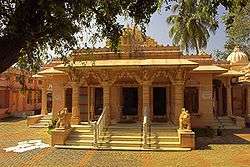Religion in Kerala
Religion in Kerala (2011)[1]
Religions in Kerala are a mixture of different faiths, most significantly Hinduism, Islam and Christianity. Kerala has a reputation of being, communally, one of the most religiously diverse and cosmoplitian states in India. According to 2011 Census of India figures, 54.73% of Kerala's population are Hindus, 26.56% are Muslims, 18.38% are Christians, and the remaining 0.33% follows other religion or no religion.[2] Various tribal people in Kerala have retained various religious beliefs of their ancestors. Hindus constitute the majority in all districts except Malappuram, where Muslims are a majority.[3]
Hinduism
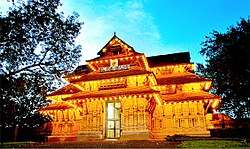
Several saints and movements existed. Adi Shankara was a Hindu philosopher who contributed to Hinduism and propagated philosophy of Advaita. He was instrumental in establishing four mathas at Sringeri, Dwarka, Puri and Jyotirmath. Melpathur Narayana Bhattathiri was another Brahmin religious figure who composed Narayaniyam, a collection of verses in praise of Krishna.
Various practises of Hinduism are unique to Kerala. Different cults of Shiva and Vishnu are popular in Kerala. Malayali Hindus also worship Bhagavathi as a form of Shakti. Almost every village in Kerala has its own local guardian deity, usually a goddess. Hindus in Kerala also strongly believe in power of snake gods and usually have sacred snake groves known as Sarpa Kavu near to their houses.[4]
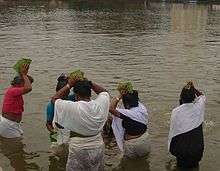
Some of the most notable temples are: Guruvayur Temple, Thrissur Vadakkunnathan Temple, Sabarimala Ayyappa Temple, Thiruvananthapuram Padmanabhaswamy Temple, Aranmula Parthasarathy Temple, Chottanikkara Temple, Chengannur Mahadeva Temple, Parassinikadavu Muthappan Temple, Chettikulangara Devi Temple, Mannarasala Temple, Chakkulathukavu Temple, Thiruvalla Sreevallabha Temple, Kaviyoor Mahadevar Temple, Parumala Panayannarkavu Temple, Sree Poornathrayesa Temple, Kodungallur Bhagavathy Temple, and Rajarajeshwara Temple. Temples in Kerala follow elaborate rituals and only priests from the Nambudiri caste can be appointed as priests in major temples. But in 2017 as per the state government's decision, the priests from backward community was appointed. These priests are assisted by a caste known as Ambalavasis.
Malayali Hindus have unique ceremonies such as Chorunu (first feeding of rice to a child) and Vidyāraṃbhaṃ.[5]
Judaism

Judaism arrived in Kerala with spice traders, possibly as early as the 7th century BC.[6] There is no consensus of opinion on the date of the arrival of the first Jews in India. The tradition of the Cochin Jews maintains that after 72 AD, after the destruction of the Second Temple of Jerusalem, 10,000 Jews migrated to Kerala.[6]
The only verifiable historical evidence about the Kerala Jews goes back only to the Jewish Copper Plate Grant of Bhaskara Ravi Varman in 1000 AD.[7] This document records the royal gift of rights and privileges to the Jewish Chief of Anjuvannam Joseph Rabban. According to some historians, St. Thomas found first converts in Kerala to his new religion amongst many of the Cochin Jews. However these Jews who accepted Christianity retained the Aramaic language once spoken by Jews in Middle East. Their descendants form the core of Syrian Christian community in Kerala. Later in the 16th century many Jews from Portugal and Spain settled in Cochin. These Jews were called white Jews as opposed to the native black Jews.
The Portuguese did not look favorably on the Jews. They destroyed the Jewish settlement in Cranganore and sacked the Jewish town in Cochin and partially destroyed the famous Cochin Synagogue in 1661. However, the Dutch were more tolerant and allowed the Jews to pursue their normal life and trade in Cochin. According to the testimony of the Dutch Jew, Mosss Pereya De Paiva, in 1686 there were 10 synagogues and nearly 500 Jewish families in Cochin. Later Britishers too were tolerant. The Jews were protected. After the creation of the State of Israel in 1948, most Jews decided to emigrate to Israel. Most of the emigrants to Israel between 1948 and 1955 were from the community of black Jews and brown Jews; they are known as Cochini in Israel. Since the 1960s, only a few hundred Jews (mostly white Jews) remained in Kerala with only two synagogues open for service: the Pardesi Synagogue in Matancherry built in 1567 and the synagogue in Parur.
Jainism
Jainism arrived in Kerala around the 3rd century BC. The Jain religion was brought to the South in the third century BC by Chandragupta Maurya (321-297 BC) and the Jain saint Bhadrabahu, according to Jain traditions. They came to Sravanabelgola in Mysore. The Jains came to Kerala with the rest of the Chera immigrants starting in the sixth century.
Among the existing original Jain temples in Kerala, the most prominent is called Jainmedu, Vadakkanthara village, about 3 km from Palakkad. This temple was reportedly built by Inchanna Satur. This indicates significant population of Jains lived in Palaghat during the 15th century. Later, various members of Marwari business community built the Jain temple in Kochi.
Some historians claim many Hindu temples might have been once Jain temples. Several places in Wyanad have Jain temples: an indication that North Malabar was once a flourishing center of Jainism. Historians believe that the decline of Jainism started about the eighth century. Jainism seems to have completely disappeared from Kerala by the sixteenth century; the foreign visitors from Europe do not mention the Jains at all.
Present day
At present, Jainism in Kerala has a small following, mainly among descendants from the original immigrating Jains, and the North Indian business community, settled in and around Kochi and Calicut.
Jains are present in significant numbers in the Wayanad district bordering the Karnataka state. Amongst the existing original Jain temples in Kerala, the most prominent is called Jainmedu, Vadakkanthara village, about 3 km from Palakkad. The remnants of the Jain temple known as Chathurmukha Basti is a popular destination in Manjeshwaram, Kasaragod.[8]
Christianity
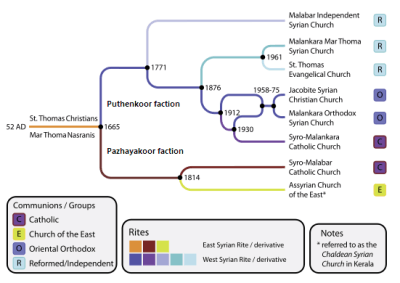
Christianity is said to have arrived in Kerala in the first century CE in AD 52 with Thomas the Apostle and is followed by 18.38% of the population.[9] The works of scholars and Eastern Christian writings say that Thomas the Apostle visited Muziris in Kerala in the first century in 52 AD to share the gospel amongst Kerala's Jewish settlements and from this came Thomasine Christianity.[10][11] The 3rd and 4th centuries saw an influx of Jewish Christians from the Middle East.
Knanaya communities arrived during this time.[12] Syriac Christians remained as an independent group, and they got their bishops from Church of the East until the advent of Portuguese and British colonialists.
The arrival of Europeans in the 15th century and discontent with Portuguese interference in religious matters fomented schism into Catholic and Orthodox communities. Further schism and rearrangements led to the formation of the other Indian Churches. Latin Rite Christians particularly on the coast of Kerala has protracted over eleven centuries and the work of evangelization was revived by the western missionaries in the 13th century.[13] Anglo-Indian Christian communities formed around this time as Europeans and local Malayalis intermarried.
Protestantism arrived a few centuries later with missionary activity during British rule.
There are various denominations/churches exist among Christians of Kerala. In that around 61% of them are Catholics and they are Syro Malabar, Latin and Syro - Malankara catholics.[14]
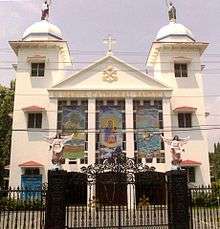
Syriac Christians in Kerala are also called Nasranis and they are Syro-Malabar Catholic Church, Malankara Orthodox Syrian Church, Malankara Jacobite Syriac Orthodox Church, Syro-Malankara Catholic Church and Marthoma Syrian Church.
Other denominations are: Church of South India, Believers Church, Pentecostal Churches, etc.
Catholic communities are Syro-Malabar Catholic Church, Latin Catholic & Syro-Malankara Catholic Church. Orthodox Communities are Malankara Orthodox Syrian Church and Malankara Jacobite Syriac Orthodox Church. All the other churches belongs to the Protestant community.
Some of the prominent churches are: St. Thomas international pilgrim church, Malayattor St. George's church, Edappally Manarcad Church, St. Mary's Church, Niranam, St. Peter and St. Paul's Church, Parumala, St. George Orthodox Church Puthuppally Pally, St. George's Church, Kadamattom, Marthoman Cathedral, Mulanthuruthy, Chengannur Pazhaya Suriyani Pally, Kozhencherry St. Thomas Marthoma Church, and Nilakkal St. Thomas Ecumenical Church
Islam
The general consensus among modern scholars is that Islam might have arrived in Kerala through Middle Eastern merchants either during the time of Prophet Muḥammad (c. 570 - 632 AD) itself or in the following few decades. The western coast of India was the chief centre of West Asian trading activities right from 4th century AD and by about 7th century AD, and several Middle Eastern merchants had taken permanent residence in the major port cites of Malabar Coast.[15] The West Asian Muslims controlled the western arm of the overseas trade to the ports of the Red Sea, and the Persian Gulf from the Malabar Coast. The native Muslims (Mappilas and Maraikkars) dominated the trade to Myanmar and Malaysia and points east, and the Indian coastal trade (Canara, Malabar, Ceylon and Coromandel, and Bay of Bengal shores) with the Chettis from Coromandel Coast. Muslims, and Vanias from Gujarat took part in the trade with ports in Western India.[16]
The Zamorins of Calicut (Kozhikode), the Hindu rulers of central Kerala, favoured Muslim navigators in the Arabian Sea in the late medieval period.[17] The arrival of the Portuguese explorers in the late 15th century checked the then well-established and wealthy Muslim community's progress.[18] The Portuguese Armadas attacked and looted the Muslim port towns in the Kingdom of Calicut.[19][20][21] The Kerala Muslims - who had been depended solely on commerce - were reduced into severe economic perplexity. Some Muslim traders turned inland (South Malabar) in search of alternate occupations to commerce. The once affluent Muslim population became predominantly rural in Kerala.[22][23]
By the mid-18th century the majority of the Muslims of Kerala were landless labourers, poor fishermen and petty traders, and the community was in a psychological retreat.[24] The community tried to reverse the trend during the Mysore invasion of Malabar District of the late 18th century.[25] The victory of the English East India Company and princely Hindu confederacy in 1792 over the Kingdom of Mysore placed the Muslims once again in economical and cultural subjection.[24][26] The partisan rule of British authorities brought the land-less Mappila peasants of Malabar District into a condition of destitution, and this led to a series of uprisings (against the upper caste Hindu landlords and British administration). The series of violence eventually exploded as the infamous Mappila Uprising (1921–22).[27][28][21][29] The Muslim material strength - along with modern education, theological reform, and active participation in democratic process - recovered slowly after the 1921-22 Uprising. The Muslim numbers in state and central government posts remained staggeringly low.[30]
A large number of Muslims of Kerala found extensive employment in the Persian Gulf countries in the following years. This widespread participation in the Gulf Rush produced huge economic and social benefits for the community. Great influx funds from the earnings of Mappilas employed followed. Issues such as widespread poverty, unemployment and educational backwardness began to change.[31] The Muslims in Kerala are now considered as section of Indian Muslims marked by recovery, change and positive involvement in the modern world.[30]
Buddhism
Buddhism probably flourished for 200 years (650-850) in Kerala. The Paliyam Copper Plate of the Ay King, Varaguna (885-925 AD)[32] shows that the Buddhists benefited from royal patronage in the 10th century.
Parsi (Zoroastrianism)
There were a number of Parsi families settled in Kerala, particularly around Kozhikode and Thalassery area. They practiced Zoroastrianism and even built the 160-year-old dadgah (fire temple) at Kozhikode which is still in existence. They were mostly wealthy families who immigrated during the 18th century from Gujarat and Bombay. The community included famous families such as the Hirjis or Marshalls.[33] Some famous Malayali Parsis included the reputed Dr. Kobad Mogaseb, who was the first medical doctor from Kozhikode who graduated from London, as well as Kaikose Ruderasha who funded the Basel Evangelical Mission Parsi High School, Thalassery.[34]
Tribal and other religious faiths
Various groups classified as tribes in Kerala still dominate various remote and hilly areas of Kerala.[35] They have retained various rituals and practices of their ancestors despite influences of mainstream religions.
Demographics
| Religion | Population | % | Dist. with highest Population | Dist. with lowest Population |
|---|---|---|---|---|
| Hindus | 18,282,492 | 54.73 | Thiruvananthapuram | Wayanad |
| Muslims | 8,873,472 | 26.56 | Malappuram | Pathanamthitta |
| Christians | 6,141,269 | 18.38 | Ernakulam | Malappuram |
| Religion | Population | % | Population below 6 yrs of age[3] | % | Dist. with highest Population | Dist. with lowest Population | Population growth since 1991[36] | Children born per women (TFR)[37] |
|---|---|---|---|---|---|---|---|---|
| Hindus | 17,883,449 | 56.2 | 1,932,504 | 50.78 | Thiruvananthapuram | Waynad | -1.55% | 1.66 |
| Muslims | 7,863,342 | 24.3 | 1,178,880 | 30.99 | Malappuram | Pathanamthitta | +1.75% | 2.97 |
| Christians | 6,057,427 | 19 | 677,878 | 17.82 | Ernakulam | Malappuram | -0.32% | 1.78 |
2001 and 2011 census (Population)
| Districts | Population(2001) | Population(2011) | Percent Hindus | Percent Muslims | Percent Christians |
|---|---|---|---|---|---|
| Thiruvananthapuram | 3,307,284 | 3,301,427 | 66.94% | 13.72% | 19.10% |
| Kollam | 2,629,703 | 2,635,375 | 64.42% | 19.29% | 15.99% |
| Pathanamthitta | 1,195,537 | 1,197,412 | 56.93% | 4.59% | 38.12% |
| Alappuzha | 2,121,943 | 2,127,789 | 68.64% | 10.55% | 20.45% |
| Kottayam | 1,979,274 | 1,974,551 | 49.81% | 6.41% | 43.48% |
| Idukki | 1,107,453 | 1,108,974 | 48.86% | 7.41% | 43.42% |
| Ernakulam | 3,279,860 | 3,282,388 | 45.99% | 15.67% | 38.03% |
| Thrissur | 3,110,327 | 3,121,200 | 58.42% | 17.07% | 24.27% |
| Palakkad | 2,810,892 | 2,809,934 | 66.76% | 28.93% | 4.07% |
| Malappuram | 4,110,956 | 4,112,920 | 27.60% | 70.24% | 1.98% |
| Kozhikode | 3,089,543 | 3,086,293 | 56.21% | 39.24% | 4.26% |
| Waynad | 816,558 | 817,420 | 49.48% | 28.65% | 21.34% |
| Kannur | 2,525,637 | 2,523,003 | 59.83% | 29.43% | 10.41% |
| Kasargod | 1,302,600 | 1,307,375 | 55.83% | 37.24% | 6.68% |
+Kerala's Percentage Distribution of Live Birth by Religion of the Family[38]
Tensions
In the 21st century various extreme religious groups have become influential in Kerala.[39][40] In 2008 there was tension in streets of Kerala over introduction of a seventh standard textbook. The controversy was about a chapter in the book Mathamillaatha Jeevan ( Life [Jeevan] without Religion). Jeevan refused to belong to any religion or caste.[41] Various groups alleged that this book was atheistic anti-religious propaganda by ruling Left Front government.[42][43]
See also
| Wikimedia Commons has media related to Religion in Kerala. |
References
- ↑ "Population by religious community - 2011". 2011 Census of India. Office of the Registrar General & Census Commissioner. Archived from the original on 25 August 2015. Retrieved 25 August 2015.
- ↑ "Population by religious communities – Census of India". Retrieved 26 August 2015.
- 1 2 "Increase in Muslim population in the State". The Hindu. Chennai, India. September 23, 2004.
- ↑ "Archived copy". Archived from the original on 2002-12-18. Retrieved 2009-07-19.
- ↑ "Vidyarambham celebrated in Kerala - India News - IBNLive". Ibnlive.in.com. Retrieved 2011-08-24.
- 1 2 Katz 2000; Koder 1973; Thomas Puthiakunnel 1973; David de Beth Hillel, 1832; Lord, James Henry 1977.
- ↑ "Sharon delighted with gift from Kochi". The Hindu. Chennai, India. September 11, 2003.
- ↑ Chathurmukha Basti, Kasaragod Malayala Manorama: Tuesday, November 29, 2005
- ↑ The Jews of India: A Story of Three Communities by Orpa Slapak. The Israel Museum, Jerusalem. 2003. p. 27. ISBN 965-278-179-7.
- ↑ Medlycott, A E. 1905 "India and the Apostle Thomas"; Gorgias Press LLC; ISBN
- ↑ Thomas Puthiakunnel, (1973) "Jewish colonies of India paved the way for St. Thomas", The Saint Thomas Christian Encyclopaedia of India, ed. George Menachery, Vol. II.
- ↑ Mundadan AM (1984). Volume I: From the Beginning up to the Sixteenth Century (up to 1542). History of Christianity in India. Church History Association of India. Bangalore: Theological Publications.
- ↑ http://www.kcbcsite.com/vwlatin.php
- ↑ http://cds.edu/wp-content/uploads/2016/05/WP468.pdf
- ↑ P. P., Razak Abdul "Colonialism and community formation in Malabar: a study of muslims of Malabar" Unpublished PhD thesis (2013) Department of History, University of Calicut
- ↑ Subrahmanyam, Sanjay."The Political Economy of Commerce: Southern India 1500-1650" Cambridge University Press, (2002)
- ↑ Menon, A. Sreedhara (1982). The Legacy of Kerala (Reprinted ed.). Department of Public Relations, Government of Kerala. ISBN 978-8-12643-798-6. Retrieved 2012-11-16.
- ↑ Nossiter, Thomas Johnson. Communism in Kerala: A Study in Political Adaptation. Retrieved 2012-11-15.
- ↑ Mehrdad Shokoohy (29 July 2003). Muslim Architecture of South India: The Sultanate of Ma'bar and the Traditions of the Maritime Settlers on the Malabar and Coromandel Coasts (Tamil Nadu, Kerala and Goa). Psychology Press. p. 147. ISBN 978-0-415-30207-4. Retrieved 30 July 2012.
- ↑ The Edinburgh review: or critical journal – Sydney Smith, Lord Francis Jeffrey Jeffrey, Macvey Napier, Sir George Cornewall Lewis, William Empson, Harold Cox, Henry Reeve, Arthur Ralph Douglas Elliot (Hon.). Books.google.com. Retrieved 17 February 2012.
- 1 2 Pg 461, Roland Miller, The Encyclopaedia of Islam, Vol VI , Brill 1988
- ↑ Miller, R. E. "Mappila" in The Encyclopedia of Islam Volume VI. Leiden E. J. Brill 1988 p. 458-66
- ↑ Nossiter, T. J. "Communism in Kerala: A Study in Political Adaptation" C. Hurst and Company, London (1982) p. 23-25 "muslims+kerala&source=gbs_navlinks_s
- 1 2 Nossiter, Thomas Johnson. Communism in Kerala: A Study in Political Adaptation. Retrieved 2012-11-15.
- ↑ Robert Elgood (15 November 1995). Firearms of the Islamic World: in the Tared Rajab Museum, Kuwait. I.B.Tauris. pp. 164–. ISBN 978-1-85043-963-9. Retrieved 25 July 2012.
- ↑ Prema A. Kurien (7 August 2002). Kaleidoscopic Ethnicity: International Migration and the Reconstruction of Community Identities in India. Rutgers University Press. pp. 51–. ISBN 978-0-8135-3089-5. Retrieved 25 July 2012.
- ↑ Nossiter, Thomas Johnson. Communism in Kerala: A Study in Political Adaptation. Retrieved 2012-11-15.
- ↑ Pg 179–183, Kerala district gazetteers: Volume 4 Kerala (India), A. Sreedhara Menon, Superintendent of Govt. Presses https://books.google.com/books?id=ZF0bAAAAIAAJ
- ↑ Cultural heritage of Kerala - A Sreedhara Menon - Google Books. Books.google.co.in. Retrieved 2012-11-16.
- 1 2 Miller, R. E. "Mappila" in The Encyclopedia of Islam Volume VI. Leiden E. J. Brill 1988 p. 458-66
- ↑ Miller, E. Roland. "Mappila Muslim Culture" State University of New York Press, Albany (2015); p. xi.
- ↑ A social history of India S. N. Sadasivan APH Publishing, 2000
- ↑ "Kozhikode's Parsi legacy". The Hindu (www.thehindu.com). Retrieved 2017-12-27.
- ↑ Thalassery, Team. "THALASSERY - Education - BEMP Higher Secondary school". www.thalassery.info. Retrieved 2017-12-27.
- ↑ Idukki - People and culture - Tribes
- ↑
- ↑ "Population Research and Policy Review, Volume 22, Numbers 5-6" (PDF). SpringerLink. Retrieved 2011-08-24.
- ↑ "Vital Statistics Reports,". Government of Kerala, Vital Statistics Division Department of Economics & Statistics Thiruvananthapuram. Retrieved 2016-06-01.
- ↑ "The Hindu : Ravi defends Antony from VS tirade". Hinduonnet.com. 2002-02-04. Retrieved 2011-08-24.
- ↑ "Welcome to Frontline : Vol. 28 :: No. 18". Hinduonnet.com. Retrieved 2011-08-24.
- ↑ "Losing their religion, in Kerala - How the World Works". Salon.com. 2008-06-25. Retrieved 2011-08-24.
- ↑ "Opposition demands withdrawal of textbook in Kerala - Chennaionline News". News.chennaionline.com. 2008-07-16. Retrieved 2011-08-24.
- ↑ "Welcome to Frontline : Vol. 28 :: No. 18". Hinduonnet.com. Retrieved 2011-08-24.
